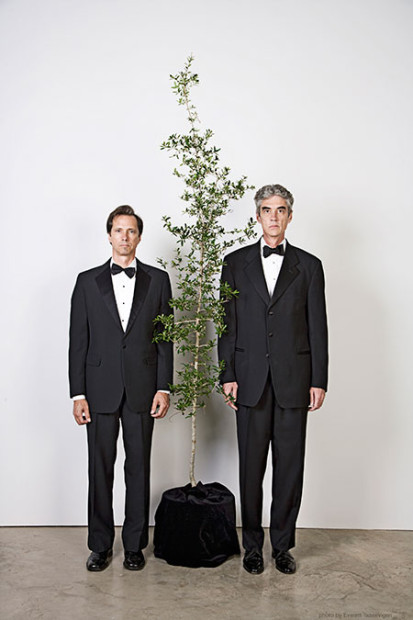[Disclosure: I am married to one of The Art Guys. I am not an impartial bystander. Read the following with that in mind.]
It was announced yesterday that the Menil Collection is removing the artwork The Art Guys Marry A Plant from its collection. Practically speaking, this means digging up a small tree and removing some stones and a plaque that surround it from the Menil’s grounds.
Here is what the Menil is going to say about this decision:
– They want to save the tree;
– They’re worried about vandalism.
Here is the truth:
– They’re tired of the controversy around the artwork;
– They need to raise money for their drawing center and want this distraction to go away;
– They don’t believe in the artwork and are sorry they ever accepted it into their collection.
[For any readers who don’t know the background of this piece, here is a primer: http://www.theartguys.com/Marry_A_Plant.html + http://www.texasmonthly.com/preview/2012-03-01/feature4 ]
Almost since its inception, The Art Guys Marry A Plant has mysteriously engendered controversy. “Mysteriously,” because the original artwork — the wedding held in 2009 at the Cullen Sculpture Garden at the MFAH, as part of a show at the Contemporary Arts Museum — was interpreted and loudly promoted by a few individuals in Houston as being homophobic and anti-gay marriage. The reasoning for this conclusion has never been completely clear, and the artists who created the piece have repeatedly denied that it is “about” gay marriage (or indeed, that it is “about” anything at all.)

So does The Art Guys Marry A Plant criticize gay marriage, and is it (and by extension, are the artists who made it) homophobic? Let’s ignore what both the artists and the critics have said, and let the art speak for itself.
The following is one of the two readings that were part of the original wedding ceremony in 2009:
From William Clifford, English philosopher and mathematician:
… we cannot suppose that so enormous a jump from one creature to another should have occurred at any point in the process of evolution as the introduction of a fact entirely different and absolutely separate from the physical fact. It is impossible for anybody to point out the particular place in the line of descent where that event can be supposed to have taken place. The only thing that we can come to, if we accept the doctrine of evolution at all, is that even in the very lowest organism, even in the Amoeba which swims about in our own blood, there is something or other, inconceivably simple to us, which is of the same nature with our own consciousness.*
Let’s repeat that last sentence: “… even in the Amoeba which swims about in our own blood, there is something or other, inconceivably simple to us, which is of the same nature with our own consciousness.”
Hm. How does one get from amoebas sharing our own consciousness to a political, moral, satirical or otherwise statement about gay marriage or gay people?
In the context of evolution, amoebas sharing our consciousness sounds quaintly positive and affirming: we are all interconnected, and all organic matter (maybe even all matter, organic or inorganic) shares some life force, some sense of itself. This concept comes partly from ideas around pantheism and panpsychism and it’s one of the central ideas underpinning The Art Guys Marry A Plant. Marrying a tree, a symbolic act that has roots in Eastern and Native American traditions, is a deceptively simple gesture that can be boiled down to “we’re all in this together, let’s take care of each other.” Personally, I think of Yoda describing the Force, but I can also guarantee that the artists weren’t thinking about Star Wars when they made this piece. They were thinking about science, and philosophy, and death, and something closer to this 1997 poem by William Meredith titled “Tree Marriage”:
In Chota Nagpur and Bengal
the betrothed are tied with threads to
mango trees, they marry the trees
as well as one another, and
the two trees marry each other.
Could we do that some time with oaks
or beeches? This gossamer we
hold each other with, this web
of love and habit is not enough.
In mistrust of heavier ties,
I would like tree-siblings for us,
standing together somewhere, two
trees married with us, lightly, their
fingers barely touching in sleep,
our threads invisible but holding.
“Tree Marriage” by William Meredith, from Effort at Speech. © Northwestern University Press, 1997. [via The Writers Almanac].

Here is the truth, which unfortunately has been utterly obscured in the drummed-up “controversy” around this artwork: this piece has nothing to do with gay marriage, and it never did.
So.
Where does that leave us? A very small, very vocal, handful of individuals in Houston have decided that, regardless of what the artists have to say about it, the artwork is homophobic and anti-gay marriage, and therefore it shouldn’t be at the Menil Collection.
What’s an institution to do?
The Menil Collection is certainly not the first museum to own an artwork that some people don’t like or choose willfully to misunderstand. There are a lot of options in such a scenario, but in a nutshell, a museum can either stand by the artwork (and the artist) and keep the piece, or it can cave and get rid of it.
The Menil Collection has caved. And now they are trying to quietly make this whole situation go away.
From 2009, the time of the original wedding ceremony, to the moment the Menil announced in mid-2011 that they would be accessioning the piece in a dedication ceremony, until last month — all through 3+ years of off-and-on, sometimes frenzied media attention — the director of the Menil Collection, Josef Helfenstein, never once communicated with the artists, either via email, or phone, or letter, or in person. He never asked them what they thought about the artwork, and certainly never lent reassurance that that the Menil would stand by them, as it stands by all the artists in its collection who were “provocateurs” during their time (more on that issue later). In addition, he made no public statement regarding the artwork whatsoever, one way or another. The director was mute.
Finally, in December 2012, The Art Guys were asked to meet with Helfenstein for a meeting in which he announced his decision to move the tree, either behind a building somewhere on the Menil campus, or preferably, off the premises entirely. The Art Guys were asked what they wanted. They said they wanted the tree to stay where it was. Their request was refused, and they were told that the tree would have to go. Given that decision, they asked to have it returned to them rather than be ignominiously hidden behind a building somewhere in Montrose.
Here we have a major museum, once known as the crown jewel in the Texas art scene, built as the legacy of visionary art collectors who were dedicated to the lives of individual artists, as was so movingly demonstrated in the recent exhibition Dear John & Dominique: Letters and Drawings from the Menil Archives. Look at the walls of the Menil Collection. Think of how many of those artists were criticized as shallow, or degenerate, or tasteless, or “provacateurs” in their own time. The Menil Collection was always so inspiring because of the independence and vision of its founders, who had the guts to follow their own taste. They fostered artists with their friendship, patronage and support, building one of the truly great art collections in doing so.
Today, the Menil Collection accepts into its collection an artwork, hosts a moving dedication ceremony for that artwork, subsequently endures a Chinese drip torture of whisper campaigns, letter writing, weeping, and ear-bending of staff and board members, claiming that the artwork (and the artists who made it) are homophobic and anti-gay marriage, and therefore by extension so must be the museum for sheltering such an atrocity. And never once, never once does that museum’s director ask the artists what the work is really about, or make any public statement regarding it.
The Menil Collection has clearly lost its way. Its decision to remove The Art Guys Marry A Plant from its collection is an institutional failure of breathtaking cowardice.
Rainey Knudson is the founder of Glasstire.
Addendum: Beyond a few news items, Glasstire has avoided covering the controversy around The Art Guys Marry a Plant because I, its founder, have a deep conflict of interest, being married to one of the artists who made the piece. But if it had been other artists involved, we would almost certainly have covered the story in depth before now, and I like to think that we would have made the effort to interview the artists and ask them, the people who made it, what this piece was all about.
* Link to the full transcript of the wedding ceremony: http://www.theartguys.com/Marry_A_Plant_vows.pdf
Update: two days after the publication of this article, the Menil Collection released the following statement:
The Menil Collection and the Art Guys removed the work The Art Guys Marry a Plant from the grounds where it has been on view since 2011. The Menil Collection wishes to make clear that it has not de-accessioned the work, nor has it taken any steps toward de-accessioning the work, which continues to be a part of the institution’s collection.
Like any art museum, the Menil Collection reserves the right to relocate works on display or to remove works from display. After damage occurred to the part of the work that is a living tree, the Menil felt it necessary to move The Art Guys Marry a Plant and discussed this proposal with the artists, who stated that they would instead prefer for the work to be put into their possession. The Menil has honored this request.
The Menil is fully aware of the intense responses that have arisen regarding this work. The Menil has engaged in numerous discussions with parties who have felt injured or offended because the work was being displayed, and parties who have felt injured or offended because the work has been vandalized and might not be displayed. The Menil has preferred to conduct these conversations in private.
The Menil seeks to engage in a vigorous conversation about contemporary works of art and their subjects. We exhibit sometimes controversial works and organize public discussions of the issues they raise, including same-sex love and gender identity. In this regard, we are proud to be presenting the current exhibition The Progress of Love and the forthcoming exhibition Forrest Bess. [via Texas Monthly]



